How Is Tres De Mayo Seen as a Masterwork of Western Art
Napoleon puts his brother on the throne of Spain
In 1807, Napoleon, bent on conquering the globe, brought Spain'southward king, Charles IV, into alliance with him in order to conquer Portugal. Napoleon's troops poured into Espana, supposedly just passing through. Simply Napoleon's real intentions presently became articulate: the alliance was a fox. The French were taking over. Joseph Bonaparte, Napoleon'southward brother, was the new king of Kingdom of spain.
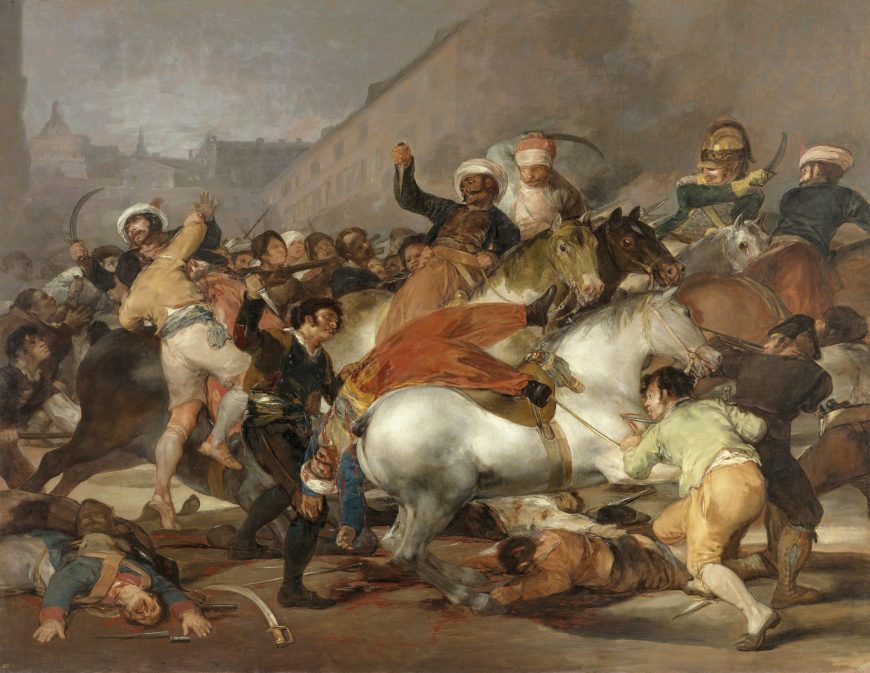
Francisco Goya, The Second of May, 1808, 1814, oil on canvas, 104.7 x 135.8″ (Museo del Prado, photo: Soerfm, public domain)
The 2nd and 3rd of May, 1808
On May 2, 1808, hundreds of Spaniards rebelled. On May iii, these Spanish freedom fighters were rounded upwardly and massacred by the French. Their claret literally ran through the streets of Madrid. Even though Goya had shown French sympathies in the by, the slaughter of his countrymen and the horrors of war made a profound impression on the artist. He commemorated both days of this gruesome uprising in paintings. Although Goya's Second of May (above) is a bout de force of twisting bodies and charging horses reminiscent of Leonardo's Battle of Anghiari, his The Third of May, 1808 in Madrid is acclaimed as one of the groovy paintings of all fourth dimension, and has even been called the earth's get-go mod painting.
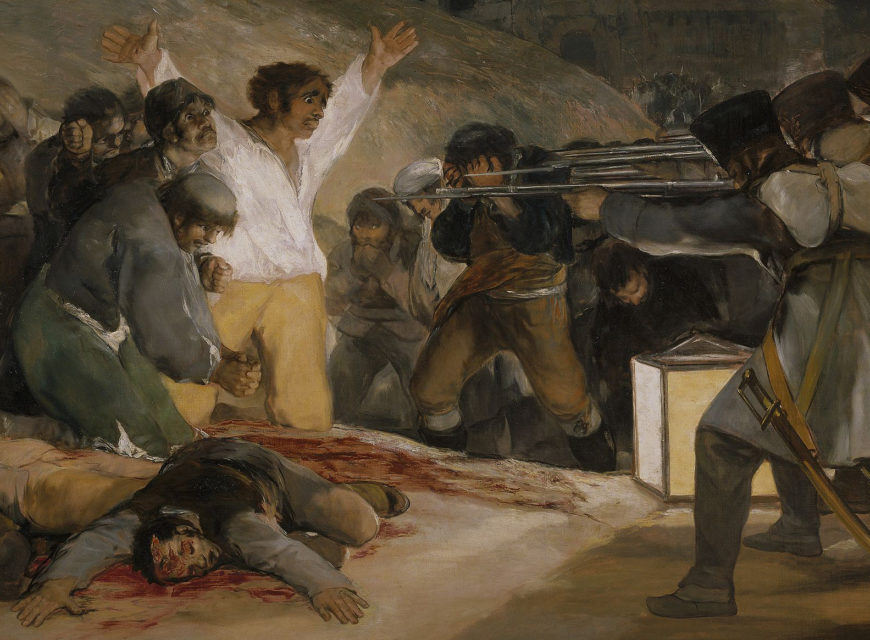
Detail, Francisco Goya, The Third of May, 1808, 1814–15, oil on canvass, (Museo del Prado, Madrid, photograph: Botaurus, public domain)
Death awaits
We see row of French soldiers aiming their guns at a Castilian homo, who stretches out his arms in submission both to the men and to his fate. A country hill behind him takes the identify of an executioner'south wall. A pile of dead bodies lies at his feet, streaming claret. To his other side, a line of Spanish rebels stretches endlessly into the landscape. They cover their eyes to avoid watching the expiry that they know awaits them. The urban center and civilisation is far behind them. Even a monk, bowed in prayer, will presently be among the dead.
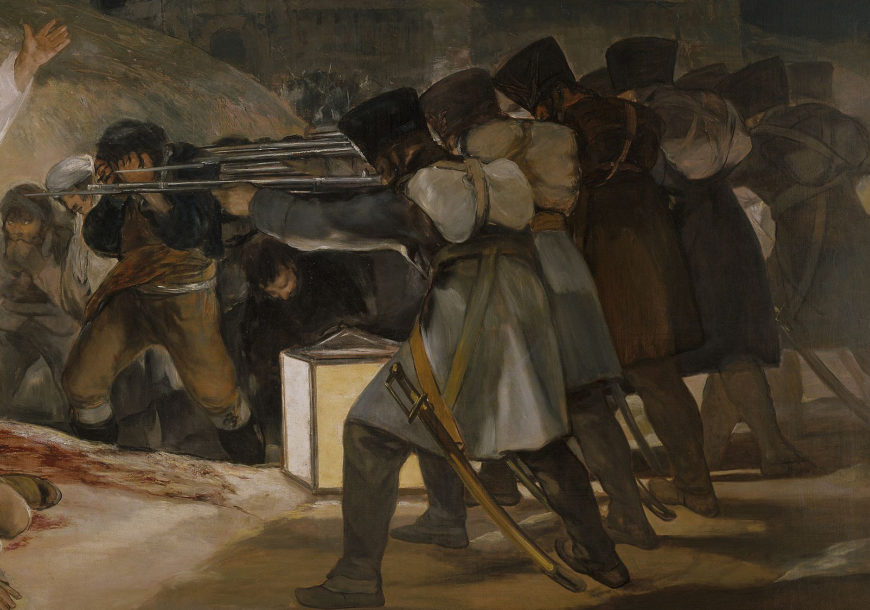
Detail, Francisco Goya, The Third of May, 1808, 1814–fifteen, oil on canvas (Museo del Prado, Madrid, photo: Botaurus, public domain)
Transforming Christian iconography
Goya's painting has been lauded for its bright transformation of Christian iconography and its poignant portrayal of man's inhumanity to homo. The central figure of the painting, who is clearly a poor laborer, takes the identify of the crucified Christ; he is sacrificing himself for the good of his nation. The lantern that sits between him and the firing squad is the only source of lite in the painting, and dazzlingly illuminates his torso, bathing him in what can be perceived every bit spiritual light. His expressive face up, which shows an emotion of ache that is more lamentable than terrified, echoes Christ'south prayer on the cantankerous, "Forgive them Begetter, they know not what they do." Shut inspection of the victim'south correct hand also shows stigmata, referencing the marks made on Christ's trunk during the Crucifixion.
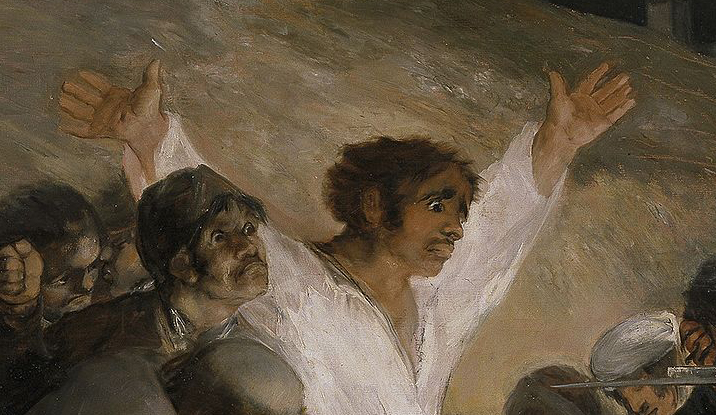
Detail, Francisco Goya, The 3rd of May, 1808, 1814–15, oil on canvas (Museo del Prado, Madrid, photo: Botaurus, public domain)
The man's pose not only equates him with Christ, only also acts every bit an assertion of his humanity. The French soldiers, past contrast, become mechanical or insect-similar. They merge into i faceless, many-legged animal incapable of feeling human emotion. Nothing is going to finish them from murdering this human being. The deep recession into space seems to imply that this type of brutality will never end.
Non heroism in battle
This depiction of warfare was a drastic divergence from convention. In 18th century fine art, boxing and death was represented as a anemic affair with little emotional affect. Even the great French Romanticists were more than concerned with producing a beautiful canvass in the tradition of history paintings, showing the hero in the heroic human action, than with creating emotional bear on. Goya'southward painting, past contrast, presents u.s.a. with an anti-hero, imbued with true pathos that had non been seen since, peradventure, the aboriginal Roman sculpture of The Dying Gaul. Goya'due south central figure is not perishing heroically in boxing, just rather being killed on the side of the route like an creature. Both the landscape and the dress of the men are nondescript, making the painting timeless. This is certainly why the work remains emotionally charged today.
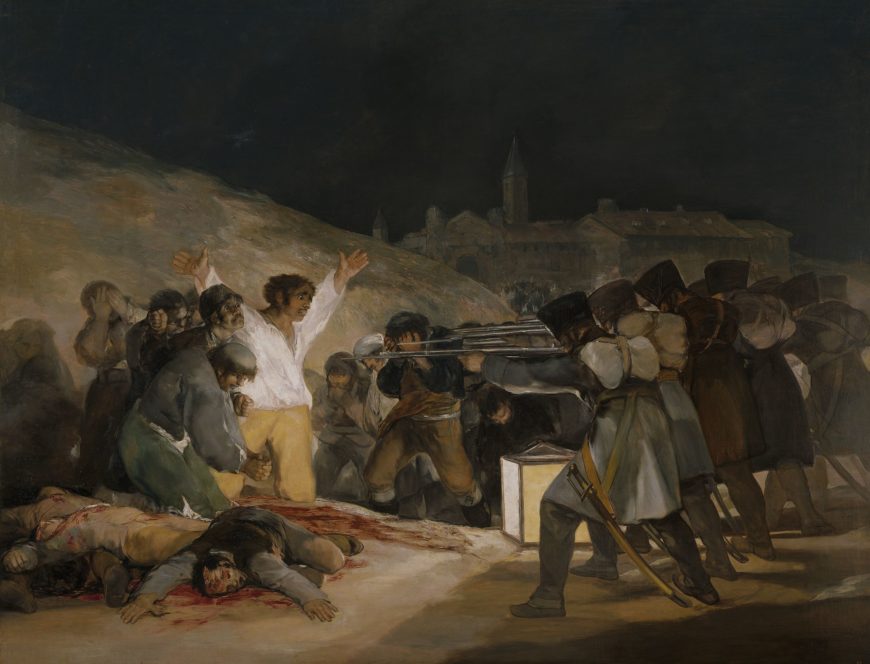
Francisco Goya, The Third of May, 1808 in Madrid, 1808, 1814–15, oil on canvas, 8′ 9″ ten thirteen′ 4″ (Museo del Prado, Madrid, photo: Botaurus, public domain)
Legacy
Time to come artists also admired The Third of May, 1808 in Madrid, and both Manet and Picasso used information technology for inspiration in their own portrayals of political murders (Manet's Execution of Emperor Maximilian and Picasso's Massacre in Korea). Forth with Picasso's Guernica, Goya's Third of May remains one of the most chilling images ever created of the atrocities of war, and it is hard to imagine how much more powerful it must take been in the pre-photographic era, before people were bombarded with images of warfare in the media. A powerful anti-war argument, Goya is not only criticizing the nations that wage war on one another, but is also admonishing u.s., the viewers, for beingness complicit in acts of violence, which occur non between abstract entities like "countries," but between human beings standing a few feet away from ane another.
Boosted resources:
This painting at the Prado Museum
Goya and the Spanish Enlightenment at the Timeline of Art History, Metropolitan Museum of Art
A brief biography of the creative person at the Getty Museum
This painting on Art Through Time
trevascusbeffight.blogspot.com
Source: https://smarthistory.org/goya-third-of-may-1808/